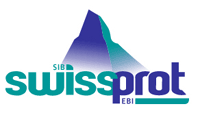

|
Swiss-Prot Protein Knowledgebase
Forthcoming changes
Release 41.1 of 25-Mar-2003
|
Table of contents
Extension of the entry name format
Reference Comment (RC) line topics may span lines
New feature key 'CROSSLNK'
Continuation of the conversion of Swiss-Prot to mixed-case characters
New format of comment line (CC) topic PATHWAY
New format of comment line (CC) topic COFACTOR
|
Extension of the entry name format
|
Not before: 01-Jun-2003
We endeavor to assign meaningful entry names that facilitate the
identification of the proteins and the species of origin. Currently
the entry name consists of up to ten uppercase
alphanumeric characters. Swiss-Prot uses a general purpose naming
convention that can be symbolized as X_Y, where X is a mnemonic code of at
most 4 alphanumeric characters representing the protein name, the
'_' sign serves as a separator, and the Y is a mnemonic species
identification code of at most 5 alphanumeric characters representing the
biological source of the protein.
We are planning to elongate the mnemonic code for the protein name from up
to 4 characters to up to 5 characters. E.g. the mnemonic code for the
meiotic recombination protein rec10 is currently 'RE10'. After the
introduction of extended entry names it could be modified to the 5-letter
code 'REC10'.
|
Reference Comment (RC) line topics may span lines
|
Not before: 01-May-2003
The RC (Reference Comment) line store comments relevant to the reference
cited, in currently 5 distinct topics: PLASMID, SPECIES, STRAIN, TISSUE and
TRANSPOSON. It is not always possible to list all information within one line.
Therefore we will allow multiple RC lines, in which one topic might span over
a line. Example:
RC STRAIN=Various strains;
could become
RC STRAIN=AZ.026, DC.005, GA.039, GA2181, IL.014, IN.018, KY.172, KY2.37,
RC LA.013, MN.001, MNb027, MS.040, NY.016, OH.036, TN.173, TN2.38,
RC UT.002, AL.012, AZ.180, MI.035, VA.015, and IL2.17;
|
New feature key 'CROSSLNK'
|
Not before: 01-May-2003
The feature key 'CROSSLNK' will be introduced to describe bonds between amino
acids, which are formed posttranslationally within a peptide or between
peptides, such as isopeptidic bonds, carbon-carbon linkages, carbon-nitrogen
linkages, tioether bonds, thiolester bonds, and backbone condensations.
Format:
FT CROSSLNK from to Description.
Note:
The feature keys 'THIOETH' and 'THIOLEST' will be removed.
Disulfide bonds occur so often in proteins, that we will keep the
special feature key 'DISULFID' to describe this kind of linkage.
|
Continuation of the conversion of Swiss-Prot to mixed-case characters
|
Continuous change
We will continue to convert Swiss-Prot entries from all 'UPPER CASE'
to 'MiXeD CaSe'. We are proceeding in the conversion of CC (Comment) lines,
we will start to convert the GN (Gene Name) lines to mixed case, but also any other
line type might be effected.
|
New format of comment line (CC) topic PATHWAY
|
Continuous change
We are gradually structuring the comment line topic PATHWAY. To describe
the biochemical pathway in which the protein is involved, we use the
following format:
CC -!- PATHWAY: biochemical pathway; nth step.[ Comment.]
Example:
CC -!- PATHWAY: Coenzyme A (CoA) biosynthesis; first step.
|
New format of comment line (CC) topic COFACTOR
|
Continuous change
The comment line topic COFACTOR is gradually being modified to the following
format:
CC -!- COFACTOR: cofactor1[, cofactor2 and cofactor3].[ Comment.]
Examples:
CC -!- COFACTOR: Magnesium.
CC -!- COFACTOR: Copper, Manganese and Nickel.
 ExPASy Home page
ExPASy Home page ExPASy Home page
ExPASy Home page

 ExPASy Home page
ExPASy Home page